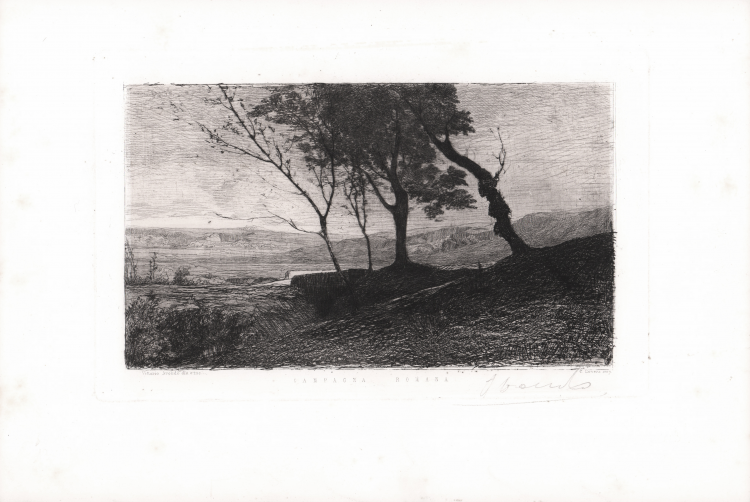



| Reference: | S42098 |
| Author | Vittorio AVONDO |
| Year: | 1870 ca. |
| Measures: | 252 x 160 mm |


| Reference: | S42098 |
| Author | Vittorio AVONDO |
| Year: | 1870 ca. |
| Measures: | 252 x 160 mm |
Etching, circa 1870, size 160 x 255 mm, impressed on coeval paper, in excellent condition. Signature in pencil in the lower right corner. Printed by chalcography Lovera in Turin.
Light, and brilliant landscape with the poetical expression of trees, that recalls the traditional Italian painting of the XIX century. The work is characterized by a well-balanced lightening which created a strong feeling of the scene, with the movement of trees in the wind through intense black made shadows and light in far behind of landscapae.
Vittorio Avondo, an artist from Turin who studied in Pisa and Geneva, and then came to the soft and nuanced naturalism of Fontanesi. He also lived in Rome from 1857 to 1865; perhaps a memory of that stay remains in this etching of the Roman Campagna (of which there are also some paintings in a private collection), a splendid piece imbued with an elegiac, melancholic atmosphere, pervaded by a vibrant light and delicate nuances. The etchings of the artist that are preserved are not many, perhaps a dozen.
We learn from Giubbini that the work was published in "L'Arte in Italia" (August 1870, table 22) with a comment by Camerana on p. 128.
Regarding the style, Giubbini commented very favorably on this etching, relating it to "the group of Appian's most 'finished' etchings"; as far as technique is concerned, he observed: "It should be noted that the process of simplification, probably already strong in the passage from the preparatory drawing to the drawing traced with the tip on the varnish, continues in the successive phases of the working of the plate through the lack or partial biting of many of the marks corresponding to the branches of the trees".
A great collector and connoisseur of medieval and modern art, as well as a landscape painter, Avondo (1836 – 1910) played a fundamental role in the cultural history of Piedmont, contributing, together with Alfredo d'Andrade, to the study and protection of the artistic heritage of the territory.
He devoted himself to painting from an early age, training in Italy, Switzerland and France. After his return to Piedmont, he became a consultant to the City of Turin and since 1863 is part of the commission responsible for selecting the works for the collections of the Civic Museum. His activities are varied: painter, antiquarian, city councilor and member of numerous cultural institutions. In 1872 he bought the castle of Issogne (Aosta) which he restored and redecorated with the help of Alfredo d'Andrade and Giuseppe Giacosa: starting from this experience he collaborated, from 1882, to the construction of the medieval village of Turin and with Emanuele Tapparelli d'Azeglio to the restoration of Casa Cavassa in Saluzzo. In 1890, he succeeded Tapparelli d'Azeglio as director of the Civic Museum: upon his death in 1910, his personal collection was transferred to the Museum.
|
G. Giubbini, L’acquaforte originale in Piemonte e in Liguria 1860 - 1875, Genova 1976, n.3; A. Dragone, J. Conti, I paesisti piemontesi dell'Ottocento, Milano, 1947; R. Maggio Serra e B. Signorelli, a cura di, Tra verismo e storicismo. Vittorio Avondo (18
|
Vittorio AVONDO(Torino, 1836 - Torino, 1910)
|
G. Giubbini, L’acquaforte originale in Piemonte e in Liguria 1860 - 1875, Genova 1976, n.3; A. Dragone, J. Conti, I paesisti piemontesi dell'Ottocento, Milano, 1947; R. Maggio Serra e B. Signorelli, a cura di, Tra verismo e storicismo. Vittorio Avondo (18
|
Vittorio AVONDO(Torino, 1836 - Torino, 1910)